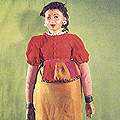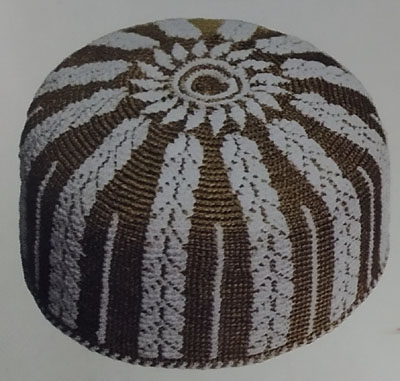The origin of the folk art of puppetry is a widely debated issue. Each country has a rich stock of stories and traditions tracing the origins of puppetry. One view is that the art of the marionette or string puppetry originated in India; another view holds that the art actually originated in Europe through the travelling Italian showmen. Puppetry traditions in Sri Lanka are believed to be Indian in origin.
HISTORY & TRADITION
In all probability, Sri Lanka, due to its proximity to India, inherited the art of string puppetry from India. In India, the western state of Rajasthan, along with south India, are believed to be the original home of string puppetry. According to references in the literary works of the time, puppetry was very popular in the ancient days of royalty in Sri Lanka. An ancient Pali treatise – the Kulavamsa – which is about Sri Lanka describes a festival held by a king in connection with a religious ceremony thus: ‘Diverse-hued mechanical figures of the gods which moved to and fro, with hands folded before the brows, with rows of mechanical figures of horses which ran hither and thither…and with elephants wearing ornaments, which were likewise mechanical figures….’ In the same piece of work there is also a reference to ‘… people who played with leather dolls and the like…’.
The marionette or the string puppet has continued to be used in puppet shows from the ancient times all across Sri Lanka. For a long time the costumes of both male and female puppets were typically Kandyan in origin, thus indicating the significant development of the art in Kandy, an area from which it has almost disappeared today. In Sinhalese, the term used for a puppet is rukada; derived from the Sanskrit words rupa and khanda, this refers to a miniature figure or replica or doll. The word rukada was used earlier to signify a figure made of wood (or any other material); however, this word is now used to solely refer to a puppet.
The carving of animal figures and puppets is a skilled art confined to particular groups of craftsmen. At some stage in the development of the art-form, some of these artisans and other members of the family began performing shows with these figures, recognising the entertainment value. The themes used in the presentations have nearly always been popular religious characters from the Buddhist Jataka stories and some well-known episodes from Sri Lankan history. These shows were intended to evoke religious fervour among the masses or to appeal to national sentiments and patriotic feelings of the audience.
Puppetry as a dramatic art form is quite a recent phenomena in Sri Lanka and the stimulus to use puppets for the purpose of drama has come from a variety of folk-drama locally called ‘nadagama‘. This art-form – a kind of operatta – is present sporadically in contemporary times: it has influenced puppet-shows in terms of forms, style, and presentation. Puppeteers now borrow freely from nadagama texts: they borrow the music and even use the instruments, like the seraphine and the drums used in nadagama. Sometimes nadagama actors themselves played the role of puppet manipulators and actors, lending their voices in the puppet play. Now that the art of nadagama is slowly dying out, many of the artistes have taken to conducting puppet shows.
The outstanding puppeteers of Ambalangoda, which is in Colombo district, have been either nadagama players or puppetry artistes trained in the Nadagama tradition. Unlike the art-form of Nadagama, puppet-plays have been able to adapt themselves to the changing circumstances and living conditions of the villages.
RAW MATERIALS, PROCESSES, & TECHNIQUES
The construction of puppets and the creation of costumes for the puppets are crafts that complement each other – they also represent complementary skills shared by the family members. The male members of the family carve the heads and make the puppets and the female members of the family assist in making the costumes and giving the figures the required finish. The craft and the skill, however, needs to be rejuvenated: the puppet makers of today are unable to impart the requisite elegance and vitality to the puppet-characters that traditional carvers deftly accomplished.
In Sri Lanka, puppets are carved using a variety of local woods, most of which grow wild in the southern parts of the country. The wood used most commonly is the vel kaduru (This is also used to make the wooden masks that Sri Lanka is famous for.) The wood is known for its lightness of weight, and a softness and pliancy that facilitate carving.
The wood is first cut into small blocks, which are well-dried and treated. The master carver then marks out the broad features of the face on it; the initial carving attempts to delineate the features as close as possible to the to the intended finished product. This requires an extremely high level of technical skill; hence there are only a few artisans accomplished in this skill.
The distinctive features of the face are carved with great care; the carver smokes the figure form time to time to facilitate carving. The limbs are carved separately; here too, skill and finesse are required, especially in carving the fingers and the hands. The limbs are then joined to the torso and the head is fixed in a traditional style commonly adopted by most puppeteers. The carving of the characters is done by a person who has proper knowledge of the story, characters, and the historical background of the period. The average size of the puppets appearing on the stage is about four feet; however, some of the principal heroes of a play are made in life-size proportions.
EXAMPLES OF CHARACTERS
Some examples of characters commonly found in almost puppet-shows are the konangi or bahu bhutaya (clown), the vidane (a sort of village official who introduces items), the sellapilai (Tamil word meaning ‘boy player’), and the dancing girl; these are all considered as traditional puppets.
CRAFT LOCATIONS
This craft is mainly confined to Ambalangoda, which is part of Colombo district; it was fairly popular several decades ago along the coastal areas of the south. Puppetry has never been significant in the hill-country or the central Provinces or Kandy region.
In the northern part of the country puppetry has been popular across generations. The puppet art indigenous to Jaffna – in the northern-most part of the country – are the bhommalatams, which means puppet dancing. This term suggests a south Indian origin to the art. Traditionally, performed in temples on festive occasions on improvised stages, these shows are much less common now.
CONTEMPORARY PERSPECTIVE & INTERVENTIONS
The traditional art of puppetry which was popular and appreciated as folk theatre in the past is still performed by troupes in the rural areas; however their number has drastically decreased. One of the main reasons for this is that the older generation of artistes do not wish to diverge from their traditional styles. The younger generation, on the other hand, find puppetry an unattractive profession. A change could happen in this scenario if puppetry is recognised both for its educational and entertainment value. Educational puppetry and puppetry as creative drama play a significant role here. An inculcation of its value at a young age can help.
A factor that has come to the aid of puppetry in Sri Lanka is that there are tourists coming to Sri Lanka from countries where puppetry is a developed form of theatre. These people are constantly in search of indigenous puppets and puppet shows. This has encouraged and revived the skilled art of puppet-carving and costuming in Sri Lanka, which has, to some extent, been transformed into a marketable handicraft. Many of the traditional highly-skilled craftsmen are there no more; however some members of the youth from the southern parts of the country, Kandy, and even Colombo have taken to making traditional as well as contemporary puppet characters. Constant updating of knowledge, skills, and technique is needed to sustain the craft.
Gallery
YOUR VIEWS
PRACTITIONERS: INDIA
Access 70,000+ practitioners in 2500+ crafts across India.
BIBLIOGRAPHY
10,000+ listings on arts, crafts, design, heritage, culture etc.
GLOSSARY
Rich and often unfamiliar vocabulary of crafts and textiles.
SHOP at India InCH
Needs to be written.






